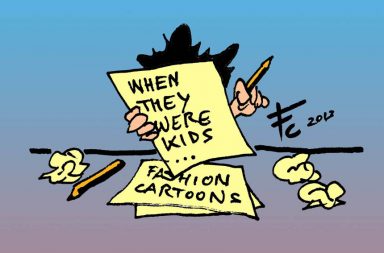Maya Zakai’s work takes us to the world of paper folding and geometry.
A felt bag that folds into triangles until it is no longer a bag. When opened, we can appreciate its design: practical, carried close to the body, creating a elongation of the person who wears it. The world of origami has been introduced to the world of accessories.

A graduate of the Bezalel Academy of Arts and Design, Maya Zakai’s project, “The Chronology of Folding” has already won the Lockman Functional Art award and will soon present her work at the upcoming Talente 2016 in Munich.
We here at So Catchy! Where Fashion Begins admire her work so we got in touch with her recently to find out more about her incredible project.

SO CATCHY!: What were you studying before focusing your attention on Accessories Design?
MAYA ZAKAI: At first I took a more general direction, studying and applying both fashion and jewelry design together but just found myself more attracted towards fabric and its connection with the body. This led me to explore different fabrics, technics and applications.
SC!: So why did you settle on Accessories?
MZ: I didn’t major in accessories per say but I did decide to focus more on accessories during my last year in Bezalel. The reason for that was the scale, accessories allow you to focus on the small details as well as the bigger picture.

SC!: Tell us about Chronology of Folding: How did you come up with the idea to create folding bags?
MZ: It all began with a blank page on which I scribbled some triangles. It didn’t start yesterday, or even a year ago, it started with my first grade notebook where I drew those triangles, also the banana we ate over recess was naturally divided in three or the cucumber inside my sandwich. The geometric shapes were easy for me to grasp and when I combined them in harmony they, in turn, created an even more complex and interesting set of shapes. As I grew older I tried to understand whether geometry was the actual base of existence of this reality of mine? Or are the shapes and patterns just part of my own human interpretation and perception?
In this project, “The chronology of folding”, I created a capsule collection of bags. The idea of making a bag came to mind because it is an everyday object which is in direct and constant contact with the body. In this project I tried to bring together two opposite notions- the softness of the material and the person carrying it, and the bag itself, which is only built from sharp angles and straight lines. This encounter intrigued me and I tried to understand the correct relations between the two. I looked for answers in my childhood and began with that blank page. I researched the art form of Origami and created folds according to the exact measurements I was looking for. I combined between the computer based graphic programs’ abilities and my own human touch and craftsmanship. The ability to reach precision in sketching gave me a huge variety of options. The many Triangles I sketched were laser cut from the soft material, which is the felt. Through the eyes of the observer you can examine the bag as a whole but the connection with the body allows you to also examine the object by its parts- the triangles, and the relations between them. The triangles, as a whole, create a volume and a 3D effect which each bag has; a volume that corresponds with the body.

SC!: Has it been difficult?
MZ: Yes quite, I had to examine different folding options, materials but also a lot of different directions. I had to choose one prototype bag from which I decided to create a collection; this choice was the most crucial one.
SC!: Are your pieces ready for sale?
MZ: All the bags, as of now, are still at their prototype stage, in order to make the next step and evolve them into everyday usable objects I will have to rethink the durance of the material and its pasted connections. I will examine the target audience of the bags and its needs, the production possibilities and the different costs. All these are on the agenda, but require a lot of thought and hard work which will only be possible with more time and economic resources.

SC!: Do you plan to sell online or create your own label anytime soon?
MZ: For now I don’t plan to sell online or create a certain label I just have my web page, which I update regularly but I am considering it for the future.
SC!: What’s your next step going to be after graduating with such an innovative project?
MZ: As of now I still feel there’s a room for me to grow so I plan to continue working in the studio and acquire more skills, technics and creative directions, whilst developing any kinds of ideas that I get in the process.
SC!: Complete the sentence: A perfect accessory has to have…
MZ: A really good and seamless connection with the body. One that you don’t even feel like you’re wearing and don’t want to take off.

SC!: An accessory you cannot stop wearing.
MZ: As you probably guessed it’s a bag, I haven’t found my perfect one yet but who knows maybe I’ll create it.
SC!: Your favorite accessories designer or label is…
MZ: Lexon, Issey Miyake, Iris van herpen,
SC!: Are there any Instagram accounts you follow or websites you normally read…
MZ: Designboom, Designmilk, CRAFT & BLOOM.

SC!: In your opinion, what’s the future of accessories design?
MZ: I feel there’s a split between the technological developments coming into fashion and the more ‘back to basics’ approach- the ecological, minimalist attitude. I feel and see the future as going somewhere in between the two, maintaining the core while still being innovative in terms of materials and approaches.
Credits:
Mentor: Yael Taragan
Photographer: Danielle Wollach
Model: Shay Trigerman
You can follow Maya Zakai on Instagram
Translation and layout by Michael Padilla




